Sony’s mid-segment smartphone comes in
various color options and retains a nice design from Arc S. The device runs on
Android 4.0 but its specs are lower than from rivals in the same segment.
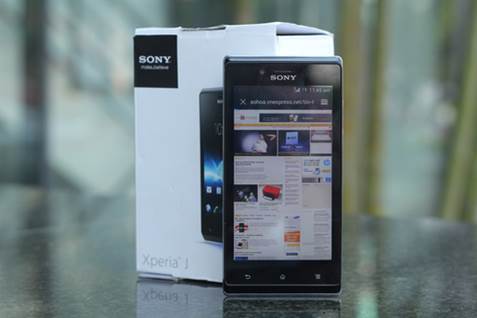
Xperia
J is an Android 4.0 smartphone from Sony’s mid-segment. RRP is $350.
Design
Xperia J was one of the four smartphones
that Sony had introduced at IFA 2012 expo. In comparison with TX or V or T
model, Xperia J has the simplest design, yet retains most features of Xperia
2012 series. The model has the front flattened and corner regularly-shaped,
making the model trendy and stylish.
Sony also puts touch-sensitive buttons in
the screen’s bottom, unlike T and TX models used physical or virtual buttons. The
display’s lower is a little tilted to make the phone look like Motorola MileStone.
It’s a little interesting that beneath J’s buttons lies a small LED that
changes change colors according to Theme.
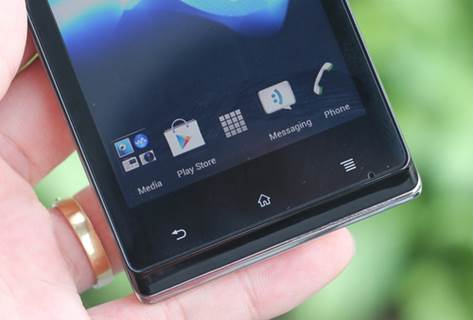
The
device has nice display and design.
Sony’s mid-segment smartphone inherits most
features from Xperia Arc and Arc S because the back is a little bent in the
middle while the head and the bottom rise out. This design helps user to hold
the phone firmly and comfortably in long use.
However, unlike previous models, Xperia J
feels better in palm thanks to its 9.2mm thickness. Xperia J is also 7g weightier
than Arc S, giving user a sturdy grip though the coat is plastic-made. Delivering
an interesting grip, Xperia J lacks a little sexiness, unlike Arc and Arc S.
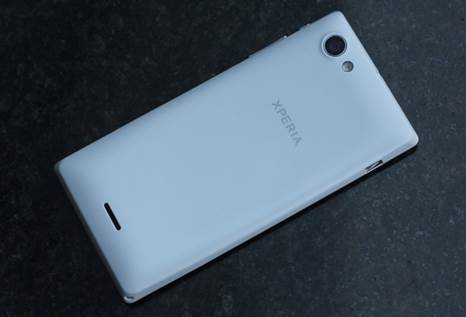
The
back lid is simple and curved, coming in various color options.
The simple back lid comes with details:
camera, flash and speaker (near the tail). The typical green logo of Sony has
disappeared, leaving the logotype “XPERIA”. Xperia J has an anti-glare smooth
finish coming in 4 color options: black, white, yellow and pink. These colors
can suite both men and women.
We dislike that physical buttons (in the
edge) were designed slim and small, making it hard to control. Adjusting volume
or turning screen off didn’t work handily and required considerable pressure
yet they were easily mistaken. Xperia J is also one of the rarest Sony
smartphones that don’t have any physical camera button. Instead, there’s a
chink for user to open the back lid.
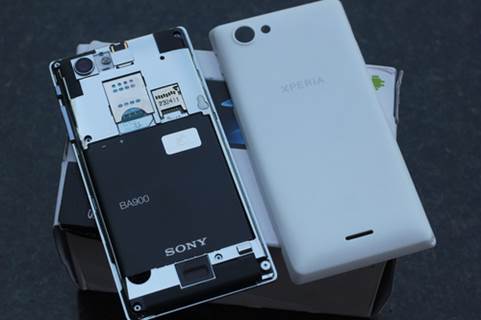
The
1,750mAh battery lies next to SIM tray and micro-SD slot.
Unlike from Xperia P or S models, we could
easily open the back lid to replace battery. SIM-tray and card slot are placed
next to the battery. But to replace the battery, user has to turn off the device
and remove the old battery.
Screen
We would like to talk about downsides
first. This mid-segment Android phone uses a TFT LCD with 16M colors instead of
LED back-lit LCD, plus Mobile Bravia Engine is unavailable. Besides, there’s no
light sensor for auto-brightness. Instead, it only turns off screen when user talks.
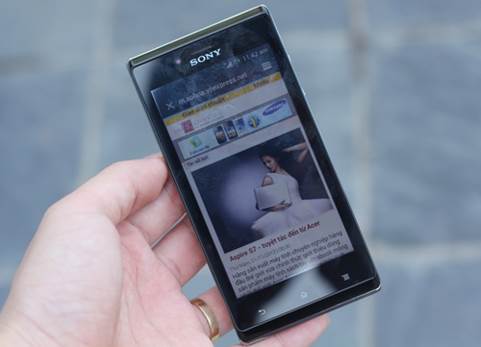
The
4in screen displays well.
Meanwhile, display is good while colors are
accurate with high contrast, even under bright-lit condition. The 480x854pixel
resolution combined uniting with the 4in size helps gives the model a nice
display though it is not as impressive as from Xperia S or Xperia P. For an
Android smartphone costing from $300 to $400, such image quality is acceptable.
It’s apparent that Xperia J’s screen is
less protected than that of most Xperia models. If necessary, user may apply external
screen protector yet the model itself can stand against scratch thanks to a
Corning Gorilla Glass layer.
Features
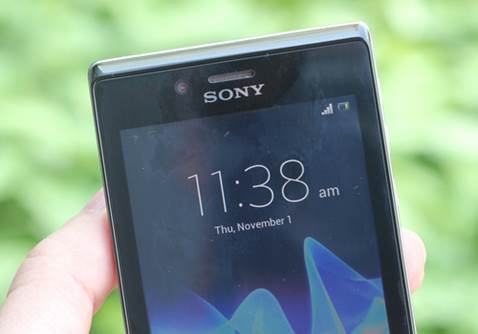
Xperia
J runs on Android 4.0 with TimeScape UI.
The Android 4.0 and TimeScape UI that Sony brought
Xperia are good equipment, giving user best functions and utilities on Android.
The UI is also deeply integrated with online services including music/movie
player, cloud storage… TimeScape is high appreciated thanks to its simple but
elegant design. The virtual keyboard works well too.
However, using Android 4.0 in such mediocre
specs (single-core chip and 512MB of RAM) slows down the system a little. Even
in action of sliding main screens, there’s still some lagging.
The new TimeScape UI has photo manager and
music player renewed while there’s a separate video player. They are all
positive improvements. User can browse photos in timelines. Plus, Walkman
properly sorts and manages music files with nice graphics and sound settings.
The standalone video player is able to manage
movies, yet it is somehow not good. Due to limited specs, Xperia J couldn’t deal
with such formats: DivX, Xvid. Only MP4 and 3GP are supported.
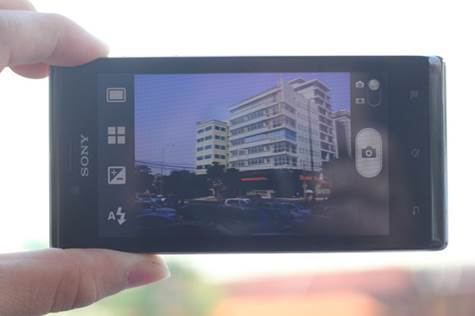
5MP
camera delivers good image quality but it supports VGA recording only.
There’s no 8MP camera like in either Arc S
or Xperia U. Xperia J has one 5MP camera. There’s also no Sweep 3D mode yet the
camera still retains some common features seen in interface or menus. It’s
still possible to use face-recognition function, Panorama or video-call through
front camera.
Primary camera provides good image quality
when details and colors are nice in closed view. However, in landscape shots
with wide-angle, colors and details are not fine. It’s a pity that the camera
only supports VGA recording.
Performance and runtime
Sony Xperia J is equipped with single-core
Qualcomm MSM7227A chipset (1GHz) featuring ARM Cortex-A5 processor, 512MB of
RAM and Adreno 200 GPU. These specs appear lower than from models in the same
segment: LG L9, Samsung Galaxy S Advance and HTC Desire X.
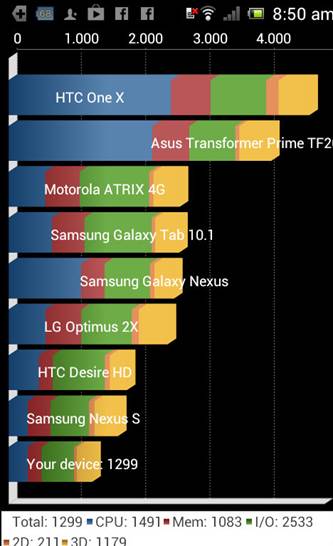
Our
test showed that Xperia J got 1,299 scores in Quadrant Benchmark Standard.
Our test showed that Xperia J got 1,299
scores in Quadrant Benchmark Standard. Its result was lower than not only from models
in the same segment but also old models such as Desire HD, Nexus S and even Arc
S. Similarly, Antutu Benchmark gave the phone 3,127 plus GPU Nenamark 2
resulted in 19.2 fps. All were showing Xperia J’s weaknesses.
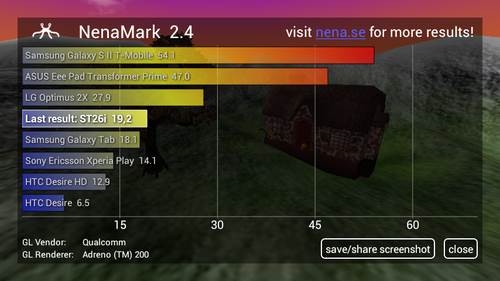
As
a compromise, the phone’s runtime shone. This device has the longest runtime in
comparison with Desire X, Optimus L7, L9 or Galaxy S Advance. Xperia J with a
1,750mAh battery could last for 2 days in usage, including continuous Wi-Fi or
3G.
|
General info
·
2G network: GSM 850 / 900 / 1800 / 1900
·
3G network: HSDPA 900 / 2100 - ST26i; HSDPA
850 / 1900 / 2100 - ST26a
·
Release date: Aug, 2012
·
Status: Available
·
Body
·
Size: 124.3 x 61.2 x 9.2 mm
·
Weight: 124 g
·
Type: Touchscreen smartphone
Display
·
Type: TFT capacitive, 16MP colors
·
Resolution: 480x854pixel, 4.0 inch (~ 245ppi density)
·
Multi-pointing: Yes, 2-finger
·
Protector: Corning Gorilla Glass
·
Misc. : TimeScape UI
Sound
·
Notification: Vibration, MP3
·
Stereo: Yes
·
3.5mm jack: Yes
Memory
·
Card slot: micro-SD (32GB max)
·
Storage: 4GB (2GB available)
·
RAM: 512MB
Data
·
GPRS: 86kbps
·
EDGE: 237kbps
·
Speed: HSDPA/7.2Mbps; HSUPA/5.76Mbps
·
WLAN: Wi-Fi 802.11 b/g/n, DLNA, Wi-Fi hotspot
·
Bluetooth: Yes, v2.1 with A2DP, EDR
·
USB: Yes, micro-USB v2.0
Camera
·
Primary: 5MP, 2592х1944 pixels, autofocus, LED
flash
·
Features: Geo-tagging, touch-to-focus, anti-shake
·
Video: Yes, VGA
·
Sub-camera: Yes, VGA
Features
·
OS: Android v4.0.4 (Ice Cream Sandwich)
·
Chipset: Qualcomm MSM7227A Snapdragon
·
CPU: 1GHz Cortex-A5
·
GPU: Adreno 200
·
Sensor: Image; accelerometer; compass
·
Message: SMS (conversation), MMS, Email, IM,
Push Email
·
Browser: HTML5, Adobe Flash
·
Radio: Stereo FM radio with RDS
·
GPS: Yes (A-GPS)
·
Java: Yes (via Java MIDP)
·
Colors: Black, white, golden, pink
·
Misc.: Social network integration; 50GB free
online storage; Anti-noise micro; MP4/H.263/H.264/WMV; MP3/eAAC+/WMA/WAV; Document
viewer; Recording/Noise dialing;Input prediction
Battery
·
Capacity: Li-Ion 1750mAh
·
Standby time: Up to 607h(2G) / Up to 618h (3G)
·
Talk time: Up to 5h 36min(2G) / Up to 7h 18min
(3G)
|